How To Clean Cat Ears
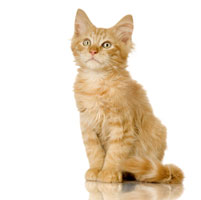 Cats normally do not require ear cleaning on a regular basis. However, your veterinarian may prescribe an ear cleaning routine for a number of reasons, including:
Cats normally do not require ear cleaning on a regular basis. However, your veterinarian may prescribe an ear cleaning routine for a number of reasons, including:
- Presence of an ear infection or wound
- Ear mite infection
- Naturally greasy ears that develop a low-grade buildup of waxy secretions.
Medicating Cat Ears
The ears usually need to be cleaned before they are medicated. Your veterinarian may make an exception to this in the early stages of treating an ear condition if the cat's ears are quite painful; the medication may then be allowed to work for a few days before attempting to clean the ears.
As long as your cat does not have a painful condition, he should tolerate the ear cleaning procedure quite well.
Ask your veterinarian to show you how to do the ear cleaning while still at the veterinary facility, and try it out there yourself. That way, any procedural questions can be addressed.
A Few Tips for Feline Ear Cleaning
Here are some tips and tricks for a successful feline ear cleaning session:
- Have all of the materials you will need close at hand before you begin so that the session is short and you do not give your cat an opportunity to go off and hide under the bed while you fumble around for supplies.
- If your cat is the type to bring the front claws up or is ready to run off before you start, consider having a family member or friend help to steady him. A soft bath towel wrapped firmly but not tightly around his body with the head exposed can help protect you, make the cat feel more secure, and keep him from skittering away. As a bonus, it will absorb any dribbled cleaning liquid.
- Do not proceed if you think your cat might bite. Contact your veterinarian for advice in this instance.
-
Be gentle. Cats have very sensitive ears. Avoid pulling hard on the ear flap.
- Avoid pushing fingers or cotton down too deep into the ear canal because the delicate lining can become irritated or damaged or the pressure may lead to pain.
- Do not pull out and up on the ear because this straightens the ear canal and makes it easier to go too deep—position the ear flap on top of the head to maintain an angle in the ear canal.
- As you steady the ear, take a little loose skin in your grasp between the fingers of the same hand you are holding the ear with. This allows you to stay with the cat if he moves away suddenly. If you hold the ear flap only, you can end up pulling the ear as he moves away, which causes pain and may make him shy about having his ear handled in the future.
- If your cat seems to be particularly sore when you clean the ears or instill cleaning solution, contact your veterinarian promptly because a broken ear drum can occur. In this case, the medication can enter the middle ear, causing extreme discomfort or damage. Also, some cats have hypersensitivity or even an allergy to some medicinal components, so the medication might need to be switched. Some cats may have deep ulcers of the lining of the ear canal, and the liquid may sting as it contacts that exposed surface.
- Praise your cat when he sits quietly for the procedure.
Demo of Ear Cleaning Procedure
Step 1: Hold the ear correctly.
This pictures shows the incorrect method—note how the ear is being pulled on and stretched up and out away from the head. The steadying hand does not touch anywhere but the ear.
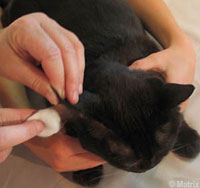
This is the correct way to hold the ear for cleaning; note the gentle anchoring of the hand to the skin over the head to help prevent a pull on the delicate ear if the kitty moves suddenly.
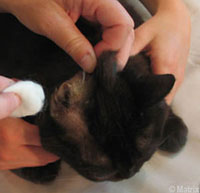
Step 2: Ear cleaning in progress.
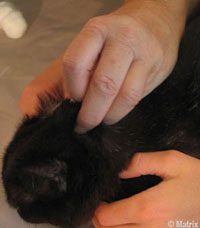
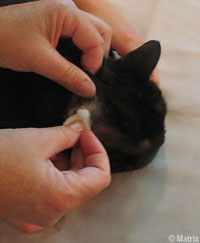
Success! See that dirty cotton ball?
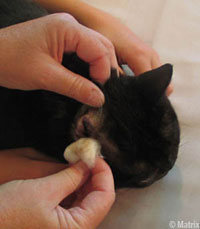
You May Also Like These Articles:
First Aid for Eye Injuries in Cats
Why Do Some Cats Have Two Different Colored Eyes?
Why Do Cats Do the Slow Eye Blink? : It's a Kitty "Eye Love You"!
Notice: Ask-a-Vet is an affiliated service for those who wish to speak with a veterinary professional about their pet's specific condition. Initially, a bot will ask questions to determine the general nature of your concern. Then, you will be transferred to a human. There is a charge for the service if you choose to connect to a veterinarian. Ask-a-Vet is not manned by the staff or owners of CatHealth.com, and the advice given should not delay or replace a visit to your veterinarian.




